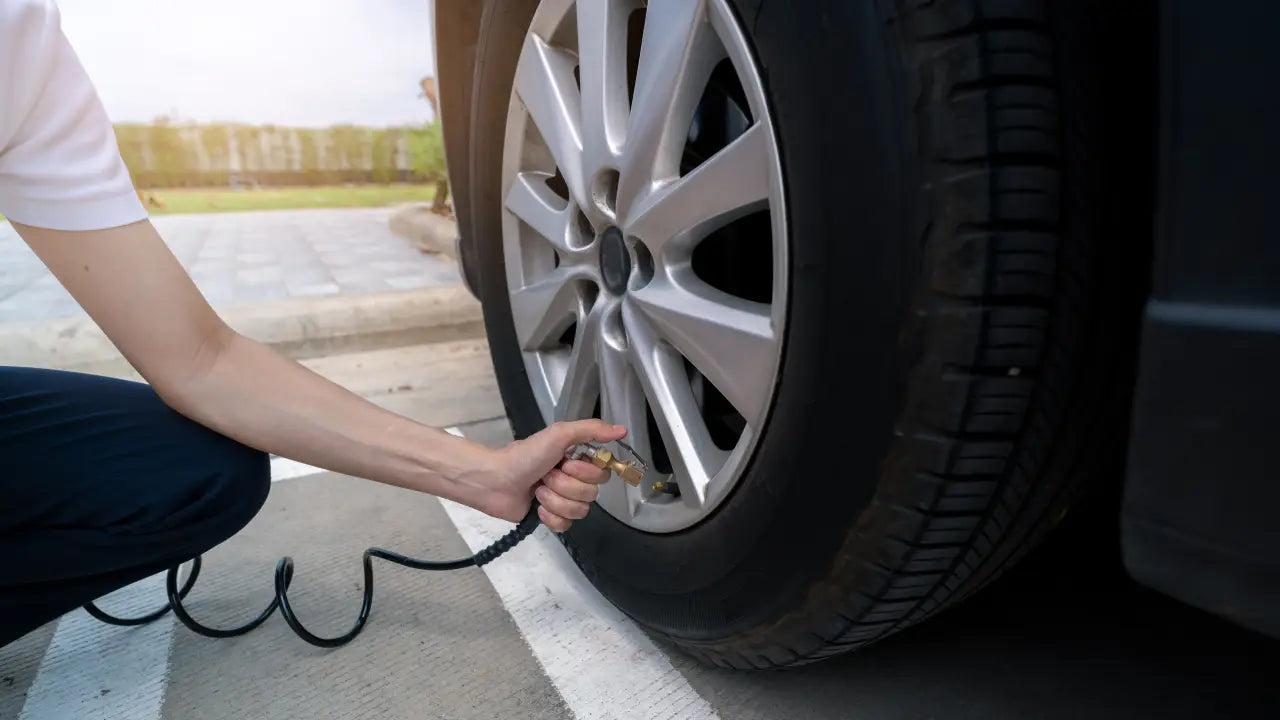適切なタイヤ空気圧を維持することの重要性
共有
適切なタイヤ空気圧を維持することは、見落とされがちですが、車両メンテナンスの重要な側面の 1 つです。空気圧不足のため、 空気圧不足のタイヤ 不均一な摩耗、ハンドリングの悪化、制動距離の増加につながります。一方で、 空気圧が高すぎるタイヤ 過剰な空気圧によるパンクの危険性の増加、乗り心地の悪化、損傷の危険性の増加を引き起こします。
しかし、 適切なタイヤ空気圧を維持することは、単にゴムを膨らませておくだけではありません。 それは影響を与える 安全性、燃費、ハンドリングとコーナリングの安定性、タイヤの寿命、 環境への影響、 等 したがって、すべてを学びたい場合は、 タイヤの空気圧を適切に維持することの重要性、 あなたがしなければならないのは、この記事を最後まで読むことだけです!

安全性
安全は、適切なタイヤ空気圧を維持する主な理由の 1 つです。タイヤの空気圧が不足または過剰であると、運転体験が損なわれ、事故のリスクが高まる可能性があります。タイヤの空気圧が低いとハンドリングが悪くなり、トラクションが低下し、制動距離が長くなりますが、タイヤの空気圧が高すぎると、特に高速走行時にパンクしやすくなります。したがって、適切なタイヤ空気圧を維持することで、車両の全体的な安全性を高めることができます。
燃費効率
適切な空気圧のタイヤは燃費の向上に貢献します。タイヤの空気圧が不足すると、転がり抵抗が増加し、車両を動かすためにより多くのエネルギーと燃料が必要になります。この非効率性は財布に影響を与え、不必要な二酸化炭素の排出につながります。したがって、適切なタイヤ空気圧を維持することで、ポンプにかかる費用を節約し、二酸化炭素排出量を削減できます。
タイヤの寿命
タイヤの寿命を延ばすことは、適切なタイヤ空気圧を維持するための最も重要な理由の 1 つです。特に走行中に盛り上がった舗装標識やランブルストリップに遭遇すると、適切なタイヤ空気圧を維持することの重要性がよりよく理解できます。盛り上がった舗装マーカーやランブル ストリップは交通安全を目的として設計されていますが、繰り返しの接触によりタイヤの摩耗につながる可能性があります。したがって、適切なタイヤ空気圧を維持すると、タイヤの寿命に対する潜在的な摩耗の影響を最小限に抑えることができます。
さらに、タイヤの空気圧が低いとトレッドが不均一に摩耗し、タイヤの早期劣化につながります。時間が経つと、早期のタイヤ交換が必要になる可能性があります。一方で、空気圧が過剰なタイヤは中央部の摩耗が早くなり、全体の寿命が短くなります。したがって、適切なタイヤ空気圧を維持することで、タイヤの寿命を延ばし、長期的にはコストを節約することができます。
ハンドリングとコーナリングの安定性
適切に空気を入れたタイヤは、最適なハンドリングとコーナリングの安定性に貢献します。タイヤの空気圧が不足していると、ステアリングが損なわれたり応答性が低下したりして、コーナーをスムーズに移動する能力に影響を与える可能性があります。一方で、タイヤの空気圧が過剰になると、乗り心地が悪化してトラクションが低下し、旋回中のコントロールを維持することが困難になる可能性があります。したがって、適切なタイヤ空気圧を維持すると、より制御された安全な運転体験が得られます。
ブレーキ効率
適切なタイヤ空気圧を維持することは、ブレーキ性能にとって非常に重要です。タイヤに空気が入っていると、接地面が大きくなり路面との摩擦が増えるため、制動距離が長くなります。このように延長された制動距離は、緊急時には危険となる可能性があります。一方、適切に空気を入れたタイヤは路面と最適な接触を提供し、より効率的で応答性の高いブレーキを容易にします。これは日常の運転や緊急事態において非常に重要であり、全体的な安全に貢献します。
オンロードでもオフロードでも快適な乗り心地
タイヤの空気圧を適切に維持することは、路上でのより快適な運転体験に貢献します。タイヤ空気圧が低くてもハンドリング性能はある程度向上しますが、タイヤ空気圧が非常に低いと車両の応答性とハンドリングが低下します。一方、タイヤの空気圧が大きすぎると、路面の凹凸や凹凸が車に伝わりやすくなり、乗り心地が不快になります。
また、タイヤ空気圧の調整は、トラクション、安定性、特にオフロード走行における快適性を最適化するために重要です。適切なタイヤ空気圧は、岩の多いトレイルでのグリップ力を高め、砂に沈むのを防ぎ、泥の中でのトラクションを向上させ、森林地帯に適応します。したがって、適切なタイヤ空気圧を維持すると、オンロードでもオフロードでもよりスムーズで快適な乗り心地が得られます。
環境への影響
タイヤの空気圧を適切に維持することは、環境に良い影響を与えます。上でも書きましたが、燃費向上に貢献します。燃料消費量の削減は、温室効果ガス排出量の削減に直接関係します。自動車は燃焼中に二酸化炭素 (CO2) やその他の汚染物質を排出します。そのため、適切なタイヤ空気圧を維持することで燃費が向上すると、走行マイルあたりの排出量が減り、大気の質や道路交通全体の環境への影響にプラスに貢献します。
ご覧のとおり、適切なタイヤ空気圧を維持することは、安全性からブレーキ効率まで、運転体験に関するすべてを向上させるために非常に重要です。車のメンテナンスや車のアップグレード部品について詳しく知りたい場合は、当社の詳細を読むだけで十分です。 「車の定期的にチェックすべきことは何ですか?」 そして 「あなたの車をより環境に優しいものにするためのアップグレードと最適化」 ブログ。
適切なタイヤ空気圧の維持に関するよくある質問
適切なタイヤ空気圧を維持するための実際的なヒントは何ですか?
- 定期点検: 少なくとも月に一度はタイヤの空気圧をチェックする習慣をつけましょう。精度を確保するために、信頼性の高いタイヤ空気圧計を使用してください。
- 最適なインフレ: 推奨タイヤ空気圧については、車両のマニュアルまたは運転席側ドア枠の情報を参照してください。タイヤにこの指定レベルまで空気を入れます。
- 冷えたタイヤをチェックする: タイヤの空気圧は温度によって変化します。タイヤが冷えているときにタイヤ空気圧を確認し、調整するのが最善です。走行によりタイヤが熱くなり、測定値に影響を与えるためです。
- 損傷の検査: タイヤに切り傷、膨らみ、穴などの目に見える損傷がないか定期的に検査してください。タイヤが損傷すると、圧力損失が発生する可能性があります。
- タイヤを回転させる: タイヤを定期的にローテーションすると、摩耗が均一になります。タイヤの状態と空気圧をチェックする追加の機会です。
- スペアに注意してください: スペアタイヤの空気圧を忘れずにチェックしてください。見落とされがちですが、緊急時には非常に重要です。
- バルブキャップを使用する: バルブ キャップは、バルブ コアに影響を与え、圧力損失を引き起こす可能性がある塵や破片に対する追加の保護層を提供します。
- 過負荷を避ける: 車の耐荷重にご注意ください。過負荷はタイヤの摩耗を増加させ、燃費の低下につながる可能性があります。
- 季節の変化を考慮する: タイヤの空気圧は季節の気温変化の影響を受けることがあります。極端な気象条件では、それに応じて調整してください。
- 高品質の圧力計に投資します。 信頼性の高い圧力計により正確な測定値が保証され、適切な膨張に貢献します。
これらの実践的なヒントを日常生活に組み込むことで、適切なタイヤ空気圧を維持し、より安全で燃費が良く、快適な運転体験に貢献します。
タイヤの空気圧はどれくらいの頻度でチェックすればよいですか?
少なくとも月に一度はタイヤの空気圧をチェックすることをお勧めします。定期的なチェックにより、圧力の不一致を早期に発見し、潜在的な安全上の問題を防ぐことができます。さらに、長距離旅行の前に空気圧をチェックし、極端な温度変化がタイヤの空気圧に影響を与える可能性があることに注意してください。
私の車のタイヤ空気圧監視システム (TPMS) は信頼できますか?
TPMS はタイヤの空気圧が著しく低下した場合に警告を発しますが、それでも毎月手動で空気圧を確認することが重要です。 TPMS は段階的な圧力損失を検出しない可能性があり、特定の圧力レベルを提供しません。ゲージを使用した定期的な手動チェックにより、精度が保証されます。












